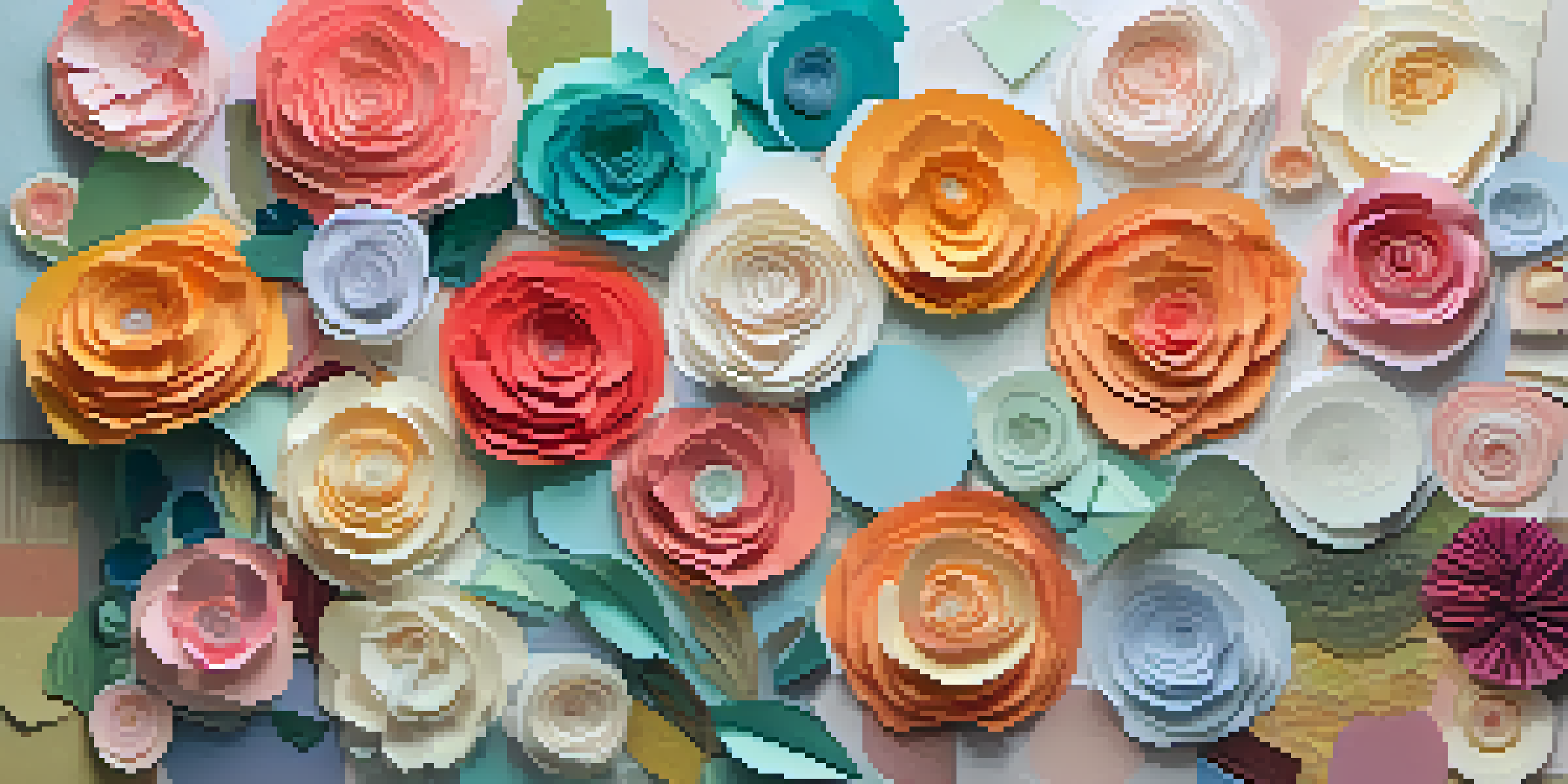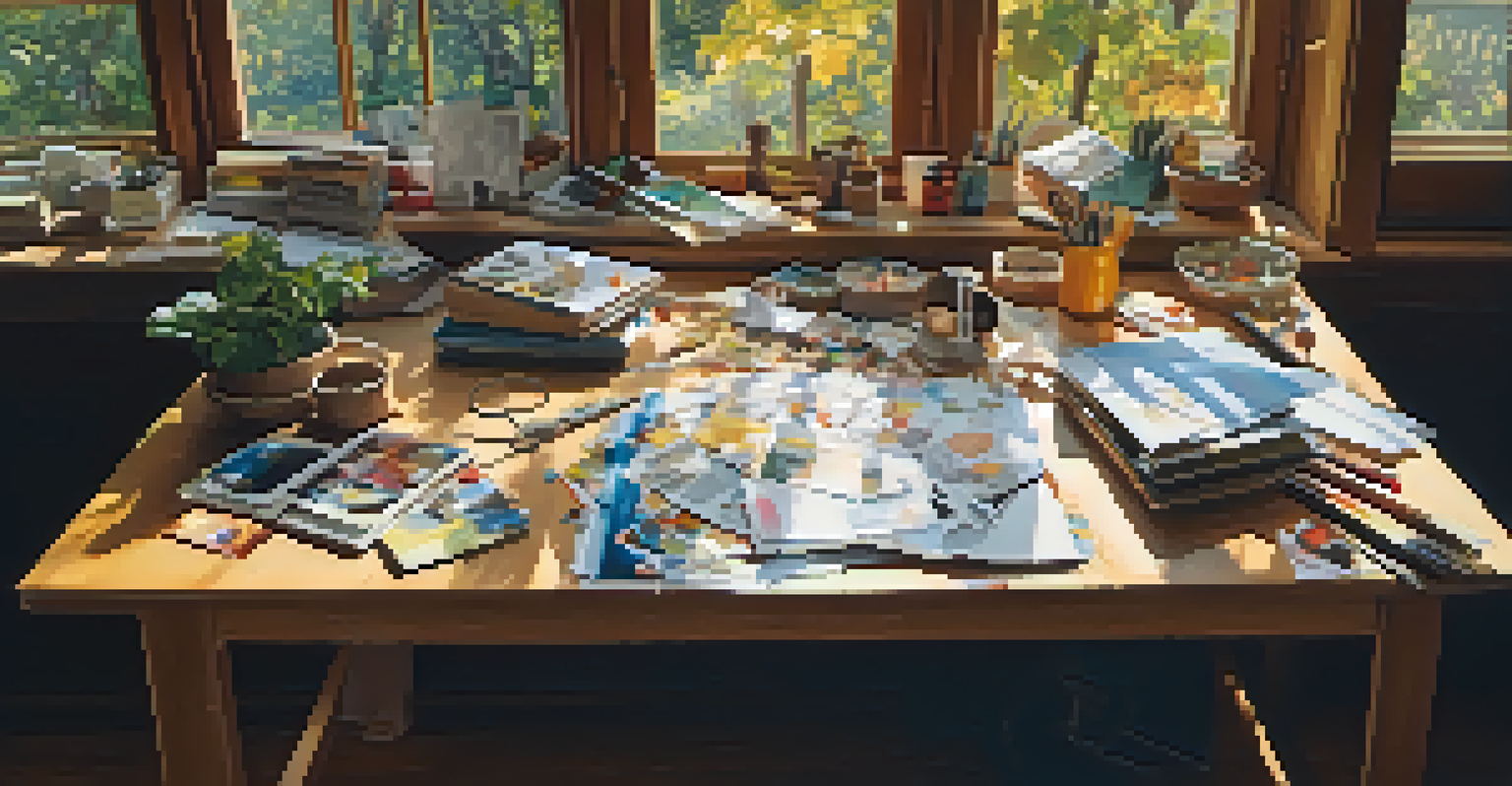Understanding the Basics of Collage Painting Techniques Today

What is Collage Painting and Its Importance Today?
Collage painting is an art form that involves combining various materials such as paper, fabric, and paint to create a cohesive piece. This technique allows artists to express their creativity in unique ways, merging different textures and colors to convey emotions. In today’s world, where digital art is prevalent, collage painting offers a tangible way to engage with art and craft.
Art is not what you see, but what you make others see.
This medium encourages experimentation, inviting artists to break free from traditional painting methods. By layering materials, artists can create depth and visual interest that is often lacking in simpler forms of art. Additionally, the accessibility of collage materials makes it a welcoming option for beginners and seasoned artists alike.
Moreover, collage painting serves as a commentary on contemporary issues, making it a powerful form of expression. Artists can incorporate found objects and imagery from magazines, newspapers, and other sources, allowing them to engage with current events or personal narratives. This relevance keeps collage painting a dynamic and evolving practice in the art community.
Essential Materials for Collage Painting
To get started with collage painting, you’ll need a variety of materials that inspire you. Common supplies include different types of paper, such as magazines, newspapers, and colored cardstock. Each type of paper brings its own texture and color, adding to the visual complexity of your artwork.

In addition to paper, consider incorporating other materials like fabric, photographs, or even natural elements like leaves. The beauty of collage painting lies in its versatility; you can use almost anything to enhance your piece. Just ensure that your materials are compatible with the adhesive you choose for sticking them down.
Collage Painting: A Unique Art Form
Collage painting combines various materials to create expressive artworks, making it a dynamic medium in today's digital age.
Don’t forget tools like scissors, brushes, and a strong adhesive, such as glue sticks or Mod Podge. These tools will help you cut, arrange, and secure your materials effectively. Having a variety of supplies on hand allows you to explore different techniques and styles, making your collage painting experience even more enjoyable.
Basic Techniques to Master in Collage Painting
When starting with collage painting, mastering a few basic techniques can elevate your work. One fundamental method is layering, where you apply materials in overlapping sections to create depth. This technique allows you to play with transparency and shadow, making your piece more dynamic.
Creativity takes courage.
Another important technique is the use of negative space. By leaving areas blank or less crowded, you can draw attention to specific elements in your collage. This contrast helps create a focal point, guiding the viewer's eye through your artwork.
Finally, consider experimenting with texture. By incorporating different materials like fabric, sand, or even textured paint, you can add a tactile quality to your artwork. This not only enhances the visual appeal but also invites viewers to engage with your piece on a sensory level.
Color Theory in Collage Painting
Understanding color theory is crucial in collage painting, as it helps create harmony and balance in your artwork. Familiarize yourself with the color wheel, which illustrates how colors relate to each other. Using complementary colors—those opposite each other on the wheel—can create striking contrasts that draw the eye.
Additionally, consider the psychological impact of colors. For instance, warm colors like reds and yellows evoke energy and excitement, while cool colors like blues and greens can evoke calmness. By thoughtfully selecting your color palette, you can communicate specific emotions or messages through your artwork.
Essential Materials for Beginners
A diverse range of materials like paper, fabric, and adhesive tools is essential for anyone looking to start collage painting.
Don’t hesitate to experiment with different color combinations to see what resonates with you. Sometimes, unexpected pairings can lead to beautiful results. Remember, the beauty of collage painting is in its flexibility, so allow your intuition to guide your color choices.
Incorporating Mixed Media into Collage Painting
Mixed media is an exciting aspect of collage painting that involves combining different artistic mediums. This could mean incorporating paint, ink, or even digital elements alongside traditional collage materials. The blending of various techniques can produce unique and unexpected results, adding an extra dimension to your artwork.
For example, you might start with a paper collage and then add painted elements or drawn details to enhance specific areas. This approach allows you to create a richer narrative or visual story within your piece. Experimenting with mixed media can also lead to personal growth as an artist, pushing you to explore new styles and techniques.
Furthermore, mixed media can serve as a way to address contemporary themes and issues. By combining various materials and styles, you can create art that resonates with your audience on multiple levels. This fusion of mediums invites viewers to engage with your work in a more profound way, making it all the more impactful.
Finding Inspiration for Your Collage Projects
Finding inspiration for your collage painting can come from various sources. Nature, everyday objects, and even your emotions can spark creative ideas. Take a walk outside or browse through magazines to gather materials that resonate with you—this can often lead to unexpected themes or concepts for your artwork.
Additionally, visiting art galleries or exploring online platforms like Pinterest can provide a wealth of inspiration. Seeing how other artists approach collage can ignite your creativity and encourage you to experiment with your techniques. Don't be afraid to draw influence from different styles and genres; this can help you develop your unique voice as an artist.
Finding Inspiration for Your Art
Inspiration for collage projects can be drawn from nature, emotions, and other artists, encouraging unique creative expression.
Journaling your thoughts and ideas can also be a helpful tool in the creative process. By jotting down your reflections or sketches, you can clarify your vision for your collage projects. This practice not only keeps your ideas organized but also serves as a reminder of your artistic journey.
Displaying and Sharing Your Collage Artwork
Once you've completed your collage painting, showcasing your work is the next exciting step. Consider framing your piece to give it a polished look, or you can display it on a canvas for a more contemporary feel. The way you present your artwork can significantly influence how it’s perceived by others.
Sharing your collage on social media platforms can also help you connect with other artists and art enthusiasts. By posting your process, from initial sketches to the finished piece, you invite others into your creative journey. Engaging with a community can provide valuable feedback and encouragement as you continue to develop your skills.

Finally, consider participating in local art shows or exhibitions to showcase your work in person. This not only allows you to share your art but also opens up opportunities for networking and collaboration with other artists. Remember, the more you share your work, the more you grow as an artist.